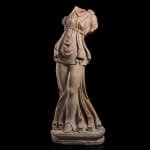Roman
Further images
Provenance
Private collection, Europe, 19th century (based on the restoration techniques)Nichan Kalebdjian (1965 - 1935) Collection, Istanbul and Paris, acquired before 1935, thence by descent
Parke-Bernet, New York, Antiquities & Other Works of Art from the Collection of the Late Nichan Kalebdjian, 24 May 1969, lot 93
Private collection, USA
Literature
The marble female statuette represents a dancing maenad, a companion of Dionysus/Bacchus, the Greek god of wine, ecstasy, and fruitfulness. The figure would originally have been complete with her head and arms, in a posture of orgiastic frenzy, with her left leg advancing, her upper torso turning to the side and the head thrown backward, the left arm following that direction, while the raised right arm would have likely been holding a musical instrument (a tympanum), or the edge of the mantle.This marble figure of a dancing maenad would probably have been made as part of a sculptural group representing the triumphal appearance of Dionysus. Complete scenes of this subject are preserved on Roman Imperial period sarcophagi and generally include Dionysus/Bacchus and a thiasos (procession) of dancing satyrs and maenads, all with musical instruments and drinking vessels, sometimes also featuring Pan, Silenus, Hermaphrodite, Erotes, centaurs, and exotic animals (elephants, panthers, lions).
The scale of the figure suggests that it was designed for a domestic villa setting, perhaps for inclusion in a peristyle garden. The peristyle courtyards and gardens of the villas belonging to wealthy Romans were filled with fountains, sculpture, and monumental ornaments, many were eclectic combinations of shapes and motifs drawn from the long, rich tradition of Classical and Hellenistic Greek art that was so popularly revived in the Roman period.
The Neo-Attic style was especially favoured for decorative reliefs such as on oscilla, marble vases, and statue bases. A number of types of dancing maenads were inspired by the creations of the Greek sculptor Kallimachus in the late 5th century BC, and the the statue of a maenad created by Skopas in the mid-4th century BC (preserved, as it is commonly believed, in the Dresden Maenad). For an Augustan version inspired by the Kallimachus figures, see the Metropolitan Museum of Art, New York, acc. no. 35.11.3
L.-A. Touchette, The Dancing Maenad Reliefs: Continuity and Change in Roman Copies, Bulletin Supplement, Vol. 62. no. 27, pp. 75–76, pl. 20b, London: Institute of Classical Studies, 1995
B. Barr-Sharrar, ‘The Dresden Maenad and Skopas of Paros’, in Paros III, Skopas of Paros and his world, Proceedings of the Third International Conference of the Archaeology of Paros and the Cyclades, Paroikia, Paros, 11-14 June 2010, Athens, 2013, pp. 321-336.
M. Bieber, The Sculpture of the Hellenistic Age, New York, 1961, pp. 182-186.
D. Grassinger, Römische Marmorkratere, Monumenta Artis Romanae XVIII, Mainz on Rhein, 1991, pp. 119-138.
B.S. Ridgway, Hellenistic Sculpture III, The Styles of ca. 100-31 B. C., Madison, Wisconsin, 2002, pp. 226-240.







